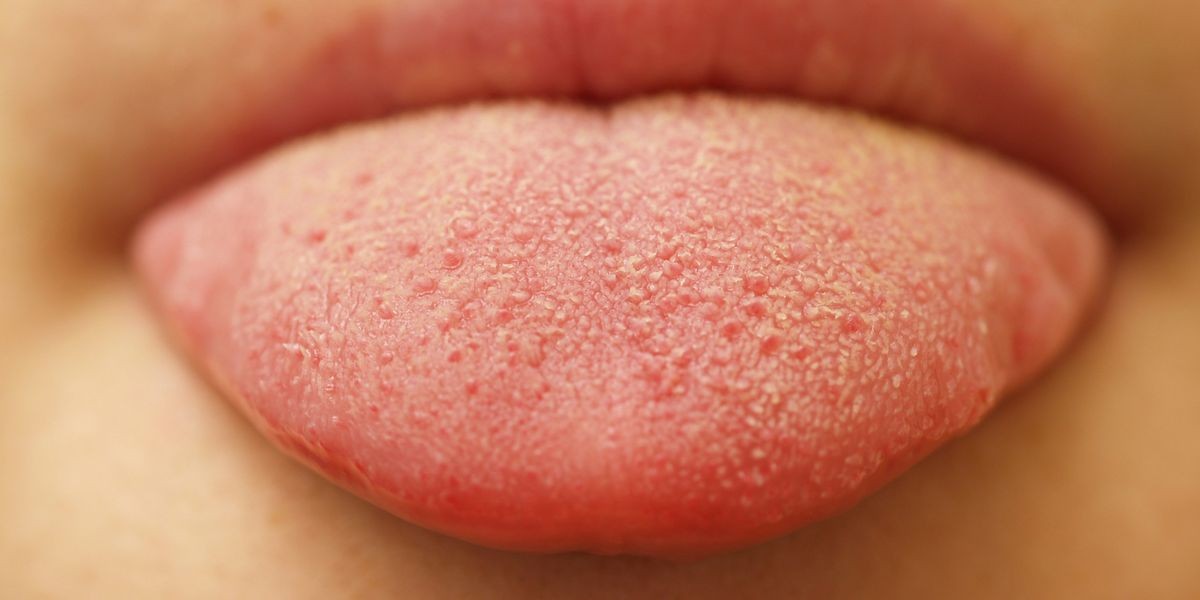
Contents
- 1 What Does It Mean When You Have Bumps on the Back of Your Tongue?
- 1.0.1 Signs and Symptoms of Tongue Bumps
- 1.0.2 Causes of Tongue Bumps
- 1.0.3 When to See the Doctor for Tongue Bumps
- 1.0.4 Diagnosing Tongue Bumps
- 1.0.5 Treatments for Tongue Bumps
- 1.0.6 Is It Bad to Scrape Your Tongue?
- 1.0.7 What Are Different Types of Tongue Scrapers?
- 1.0.8 5 Benefits of Tongue Scraping
- 1.0.9 From
What Does It Mean When You Have Bumps on the Back of Your Tongue?
We all have several hundred bumps on our tongues called papillae, also known as the taste buds. Inflamed bumps on the back of your tongue — the circumvallate papillae — usually heal on their own.
There are four types of papillae on our tongues:
- Filiform papillae, which cover about two-thirds of the tongue and are responsible for its sense of touch
- Fungiform papillae, which distinguish flavors and temperature
- Foliate papillae, found on the sides of the tongue
- Circumvallate papillae, large bumps toward the throat in a V-shape
Normally, these bumps are mostly unnoticeable, having a consistent color and texture that support eating.
But sometimes tongue bumps can appear swollen. While enlarged papillae may be a short-term nuisance, they can also make it difficult or painful to eat, talk, swallow, or taste food.
Inflamed bumps on the back of your tongue — the circumvallate papillae — usually heal on their own. However, severe, spreading, or long-lasting bumps might be a sign of another underlying condition that requires a doctor’s treatment.
Because your oral health is closely tied to your overall well-being, it’s important to know why you have bumps on your tongue and when to seek medical care.
Signs and Symptoms of Tongue Bumps
Inflamed bumps on the back of your tongue are usually visible, appearing larger and swollen. They may also change color, turning white, bright pink, or black.
Enlarged taste buds may also cause:
Change in Taste
The papillae on the back of your tongue are not responsible for taste. But if the inflammation spreads, you may experience a partial or total loss of taste sensation or have difficulty discerning between flavors like salty, bitter, sweet, or sour.
Difficulty Moving Your Tongue
As the bumps on the back of your tongue swell, it can be hard to move it normally.
Depending on the severity, this could impact speaking and swallowing. Swelling can also make your tongue sore and appear larger — in some cases, the top and bottom teeth do not fit neatly together around the tongue.
Pain or a Burning Sensation
While enlarged bumps can make your tongue sore, you may also experience a localized burning sensation in the problem area. This might be an ongoing discomfort or only when the tongue is in use, like during eating.
A Furry or Hairy Texture
Debris, bacteria, and dead skin cells can get lodged between inflamed tongue bumps. This accumulation causes a white, fuzzy coat on the surface of your tongue.
QUESTION
Causes of Tongue Bumps
Tongue bumps are common and generally harmless, but they can also be a symptom of a more serious condition.
You may experience bumps on the back of your tongue due to:
Physical Trauma
Accidentally biting your tongue can irritate your taste buds, making them swell. Eating or drinking extremely hot food can also burn and blister papillae.
Allergies
Sometimes an allergic reaction causes tongue bumps, especially with certain fresh fruits and vegetables that contain pollen species like melons, apples, and bananas.
Infection
Oral infections can spread to your taste buds, leading to enlarged bumps. The most common infection is oral thrush, caused by the yeast Candida albicans. Signs of oral thrush include swollen tongue bumps, white lesions, burning, and soreness.
Tongue bumps are also a symptom of other infections like herpes simplex and syphilis. Certain antibiotics can cause swollen taste buds as a side effect.
Poor Oral Hygiene
If you do not maintain good brushing and flossing habits, bacteria can build up and cause inflammation in your mouth, including in your taste buds. Smoking can also have this effect.
Dehydration
Not drinking enough water can cause dry mouth, increasing your risk of taste bud infections, gum disease, and dental cavities over time.
Stress
Canker sores can form at the back of your tongue as well. While the cause is not well understood, research shows that psychological stress may trigger canker sores. Physical irritation, acidic fruits and vegetables, and hot spicy foods can also contribute to canker sores.
Disease
While uncommon, bumps on the back of the tongue can be a sign of oral or tongue cancer. These wart-like bumps, or squamous cell papillomas, can be white or red and may be benign. Only a doctor can diagnose an unusual bump as cancerous.
Leukoplakia is another condition that can cause tongue bumps. It occurs when the cells in your mouth grow excessively, irritating your taste buds. Some people with diabetes, anemia, and autoimmune diseases may also experience inflamed tongue bumps.
When to See the Doctor for Tongue Bumps
Most enlarged tongue bumps will heal on their own, but you should visit your doctor if:
- Your symptoms last longer than a week
- Bumps are growing, spreading, or bleeding
- Enlarged bumps keep returning after healing
- Painful bumps interfere with your ability to eat or drink
Diagnosing Tongue Bumps
To diagnose the cause of your tongue problem, a doctor will ask about your medical history and any known allergies. They will perform a tongue exam to look for changes in taste bud color, texture, and size, checking for irregularities to guide treatment.
Your doctor might also order blood tests to rule out other issues like infection or disease. If cancer is suspected, the doctor will refer you to a specialist to perform a biopsy or remove the lump.
Treatments for Tongue Bumps
Some causes of tongue bumps require treatment from a doctor, like antifungal medications for oral thrush.
However, you can relieve discomfort caused by most tongue bumps at home. Some home remedies include:
- Drinking lots of water, through a straw if more comfortable
- Rinsing your mouth with warm salt water
- Avoiding acidic and spicy foods and alcohol-based mouthwashes that irritate inflammation
- Using topical numbing gels or creams
- Taking over-the-counter anti-inflammatory and pain relief medication like ibuprofen
- Not smoking or drinking alcohol
You should monitor the size, color, and spread of tongue bumps as you treat them at home. If there is no change or your condition worsens, make an appointment with your doctor.
The best home care you can do is prevention. Maintaining good oral hygiene can help prevent inflamed bumps at the back of your tongue and keep them from recurring.
Is It Bad to Scrape Your Tongue?
Tongue scraping is a way of removing bacteria, food particles, and other debris that cause bad breath from the surface of your tongue. It is a painless and low-risk procedure. However, there may be some associated risks, such as:
- Pain or bleeding
- Activation of gag reflex
- Harm to taste buds, altering taste sensations
However, if done correctly and using the right technique, tongue scraping can improve oral health and minimize foul breath (halitosis).
What Are Different Types of Tongue Scrapers?
Tongue scrapers come in various shapes and sizes:
- Brush tongue scrapers: Typically have a long handle like a toothbrush and a tip with ridges or short bristles to scrape the tongue. They must be replaced every 3-4 months of regular use.
- Plastic tongue scrapers: Made of thin plastic wire bent into a U-shape.
- Metal tongue scrapers: Made of thin, U-shaped metal wire. Copper and stainless-steel tongue scrapers can be used indefinitely if cleaned regularly. Copper also has antibacterial properties that help eliminate microbes.
To use a tongue scraper, start at the base of the tongue and pull the scraper forward to scrape away buildup.
By clicking Submit, I agree to the MedicineNet’s Terms & Conditions & Privacy Policy and understand that I may opt out of MedicineNet’s subscriptions at any time.
5 Benefits of Tongue Scraping
- Improves sense of taste: Scraping removes dead cells and buildup from the surface of the tongue, creating space for taste buds to function optimally.
- Freshens breath: Tongue scraping removes bad-breath causing bacteria.
- Reveals the tongue’s natural color: Regular scraping removes discoloration caused by debris on the tongue, helping it return to its natural, pink, and clean state.
- Boosts immunity: Scraping prevents the buildup of bacteria that can weaken the immune system over time.
- Promotes better digestion: Scraping prevents the accumulation of mucus or other buildup, which can disrupt normal messaging function and affect digestion.
From
Oral Health Resources
- Bad Breath: See How to Stop It
- Natural Ways to Whiten Your Teeth
Featured Centers
- What Are the Best PsA Treatments for You?
- Understanding Biologics
- 10 Things People With Depression Wish You Knew
American College of Allergy, Asthma & Immunology: "Pollen Food Allergy Syndrome."
American Dental Association: "Tongue Scrapers and Cleaners."
Annals of Saudi Medicine: "Human Biology of Taste."
Better Health Channel: "Tongue."
Cancer Research UK: "What is tongue cancer?"
Cedars-Sinai: "Everything You Ever Wanted to Know About Canker Sores."
Clinics: "Psychological Stress and Recurrent Aphthous Stomatitis."
Health Direct: "Allergic reactions to antibiotics."
Mayo Clinic: "White Tongue."
Mount Sinai: "Leukoplakia."
Stanford Medicine: "Examination of the Tongue."
University of Michigan: "Mouth Problems, Noninjury."
WebMD: "Tongue Scraping: What to Know."


